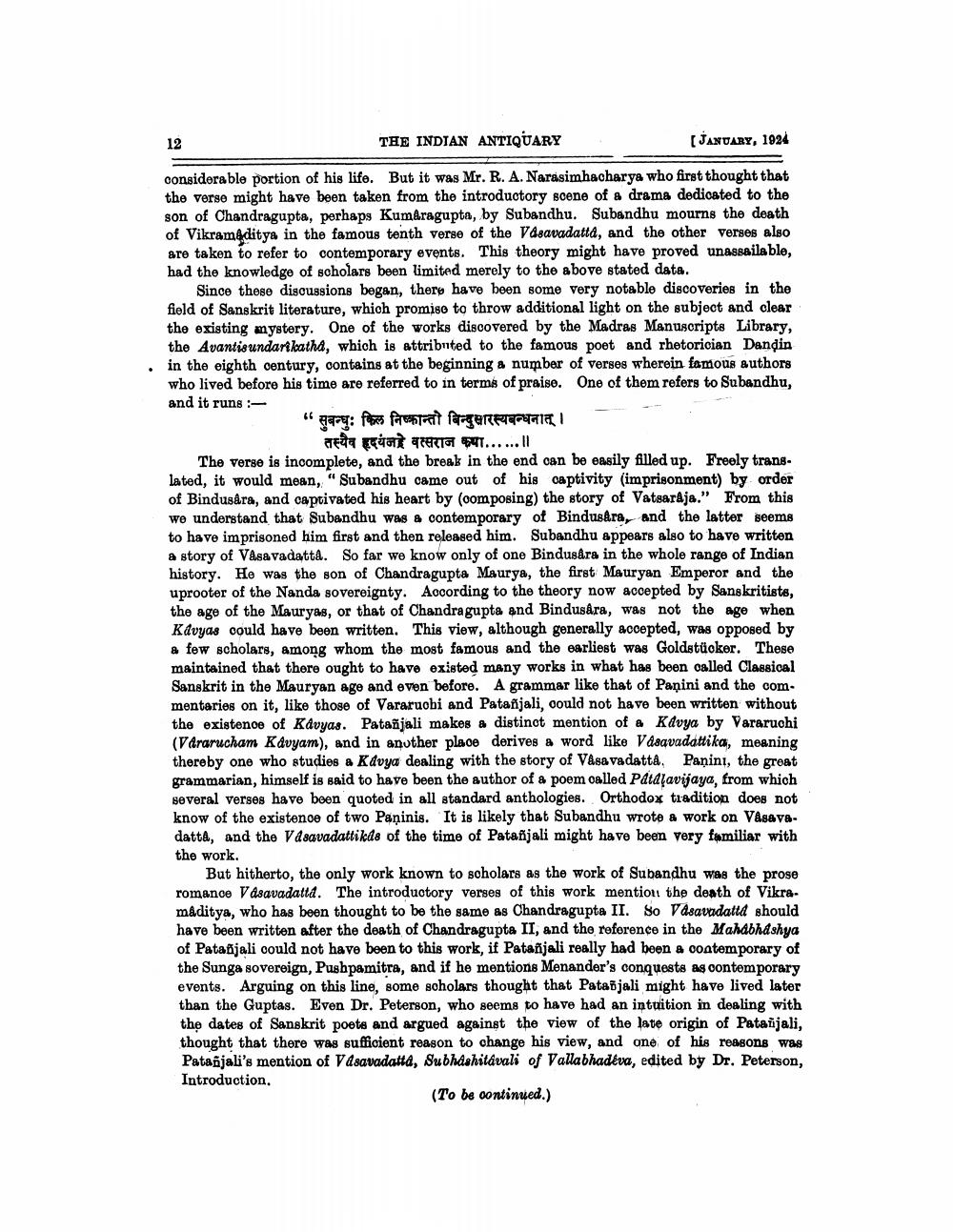________________
THE INDIAN ANTIQUARY
[JANUARY, 1924
considerable portion of his life. But it was Mr. R. A. Narasimhacharya who first thought that the verso might have been taken from the introductory scene of a drama dedicated to the son of Chandragupta, perhaps Kum&ragupta, by Subandhu. Subandhu mourns the death of Vikramaditya in the famous tenth verse of the Vasavadatta, and the other verses also are taken to refer to contemporary events. This theory might have proved unassailable, had the knowledge of scholars been limited merely to the above stated data.
Since these discussions began, there have been some very notable discoveries in the field of Sanskrit literature, which promise to throw additional light on the subject and clear the existing mystery. One of the works discovered by the Madras Manuscripts Library,
the Avantisundarikatha, which is attributed to the famous poet and rhetorician Dandin . in the eighth oentury, oontains at the beginning a number of verses wherein famous authors
who lived before his time are referred to in terms of praise. One of them refers to Subandhu, and it runs :
"gara: Pes Parenta farger RETTI
Teha iad THEIG ...... The verse is incomplete, and the break in the end can be easily filled up. Freely translated, it would mean, "Subandhu came out of his captivity (imprisonment) by order of Bindusara, and captivated his heart by (oomposing) the story of Vatsaraja." From this we understand that Subandhu was a contemporary of Bindusara, and the latter seems to have imprisoned him first and then released him. Subandhu appears also to have written a story of Vasavadatta. So far we know only of one Bindusara in the whole range of Indian history. He was the son of Chandragupta Maurya, the first Mauryan Emperor and the uprooter of the Nanda sovereignty. According to the theory now accepted by Sanskritists, the age of the Mauryas, or that of Chandragupta and Bindusara, was not the age when Kavyas could have been written. This view, although generally accepted, was opposed by a few scholars, among whom the most famous and the earliest was Goldstücker. These maintained that there ought to have existed many works in what has been called Classical Sanskrit in the Mauryan age and even before. A grammar like that of Panini and the commentaries on it, like those of Vararuobi and Patañjali, oould not have been written without the existence of Kavyas. Patañjali makes a distinot mention of a Kavya by Vararuchi (Vararucham Kavyam), and in another place derives a word like Vasavadattika, meaning thereby one who studies a Kavya dealing with the story of Vasavadatta, Panini, the great grammarian, himself is said to have been the author of a poem called Patasavijaya, from which several verses have been quoted in all standard anthologies. Orthodox tradition does not know of the existence of two Paņinis. It is likely that Subandhu wrote a work on V&savadatta, and the Vasavadattikde of the time of Patañjali might have been very familiar with the work.
But hitherto, the only work known to scholars as the work of Subandhu was the prose romanoe Vasavadatta. The introductory verses of this work mention the death of Vikramaditya, who has been thought to be the same as Chandragupta II. So Vasavadatta should have been written after the death of Chandragupta II, and the reference in the Mahabhashya of Patañjali could not have been to this work, if Patañjali really had been a contemporary of the Sunga sovereign, Pushpamitra, and if he mentions Menander's conquests as contemporary events. Arguing on this line, some scholars thought that Patañjali might have lived later than the Guptas. Even Dr. Peterson, who seems to have had an intuition in dealing with the dates of Sanskrit poets and argued against the view of the late origin of Patanjali, thought that there was sufficient reason to change his view, and one of his reasons was Patanjali's mention of Vasavadatta, Subhdahitavali of Vallabhadeva, edited by Dr. Peterson, Introduction.
(To be continued.)




